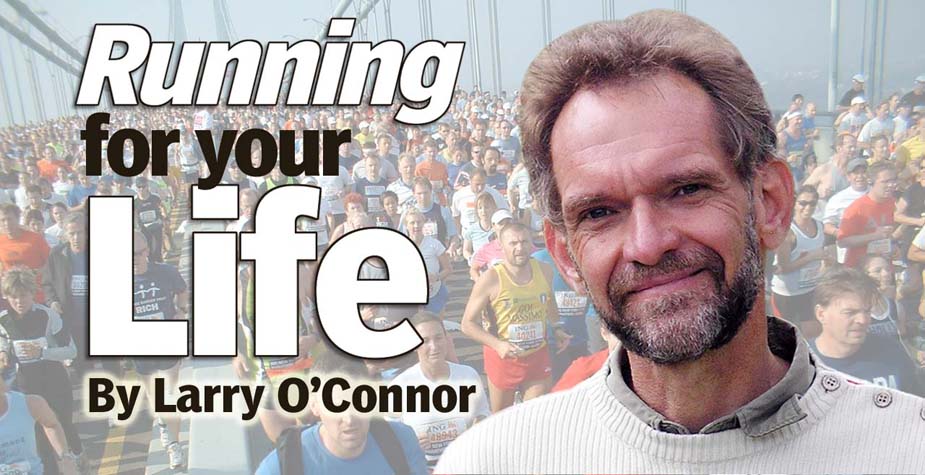I dodged a bullet. Or at least that’s how it feels. Last Wednesday (Dec. 7) I was heartsick, certain that I’d set myself back in my training by a month, maybe longer. Today, though, I’m hopeful. Only three days off and I loped my way through a five-miler on Sunday. Barely feeling the muscle pull, tear in the upper thigh of my left leg, the bad one, the one inflicted with DVT, the one that swells up in the calf when I run because the vein valves are shot, the oxygen-rich blood feeds the muscles on a run, but they’re slow to return to the heart, causing swelling, no pain to speak of but an injury with this leg is especially concerning.
But three days’ rest seems to have done the trick. Back to square one. Day one, week one begins Monday (Dec. 12): Target: 30 miles and the long run a tidy eight miler, a rest day of stretching-only built in. And maybe, looking for blessings, that Thurb run injury last week happened for a reason. Respect karma. It has come to me that I was meant to be “pulled” into injury for a two-fold reason: One: That I’ll set aside my running/Thurb! time until after Boston and Two: I will not only stride and strengthen but stretch. Every day.
At our Christmas neighborhood block party on Saturday night (Dec. 10) a friend told me she would be a regular reader of the blog if only she didn’t feel a sense of loss in reading about what she said she can only dream about. An avid runner for decades, A told me her body has let her down. Not every part, she says. But her back. Is there anything I can do? she asks. I would so much love to return to running. I miss it.
A recent evening a second friend about the same age as A (not so much older than me) got to talking about his relationship to running. He, too, says he misses running. But unlike A, he’s resigned to devoting himself to non-running exercises. During his running years his knees started to bother him about a decade ago, and after consulting with a doctor who advised him that the pounding of that exercise would only make the trouble worse, he bought a stationary bike and now he works out as a cyclist. The knee problem vanished, and he sees this the exercise regimen as his new normal. He doesn’t even remotely think that he will be able to run again.
Like author Haruki Murakami – who is six years older than me – I consider myself lucky. Haruki writes in “What I Talk About When I Talk About Running” about how his body just keeps going. I’ve never had a running coach, or even a personal trainer. In many ways I’m not so different than the young man who started running going on four decades ago. Running just fit for me. From the beginning. And yeah I’ve had my injuries, but except for the overtraining one last March when I tore my hamstring severely, they’ve been minor: some forefoot pain, shins splints. But the knees and back, knock on wood, they’re like new.
I’ve been thinking about what my friend A said at the Christmas party. Unlike my stationary bike friend, she’s bound and determined not to take no for an answer. Or at least she will exhaust all avenues before doing so.
Short of seeing X-rays of A’s back, I’d advise core exercises. My wife M does them and they’ve made a big difference in terms of back pain relief. Specific types are available in a key stroke.
But when it comes to running exercises, one area of focus is no panacea. It’s all about striking that balance, especially for us aging runners. Aging weakens and slows our bodies, but daily aerobic exercise – whether with weights or running or biking, etc. – retards that loss. The catch is we must exercise smartly: not build up too much strength in our quads while undertraining our hammies. Core and back and upper body, Achilles tendons . . . all of them need to be stretched and strengthened.
There are no shortcuts. In your 50s, running for your life means training for your life. Want to run a sub-four-hour marathon at 60? Set aside the time every day to become fit, develop core health and good, if not impeccable, dietary habits: grains, fruit, fish and Omega III supplements.
But then D-Day comes for A. When she feels ready to try again. To run. I wish her well.
I don’t know if I believe in anatomy is destiny. But in my case it has helped. I could do upper body exercises for a year, every day with protein drinks and progressively heavier weights and still have modestly built chest and arms.
But when I run my head lifts as if on a string, I feel my ankles go soft, and when I listen to my footfalls they, too, are soft, like petals; if they feel otherwise I imagine that I’m running on ice rather than pavement, lightening the stride even more and soon I’m moving virtually soundless through the park.
Next: Running for Your Life: Road Home

0 comments:
Post a Comment